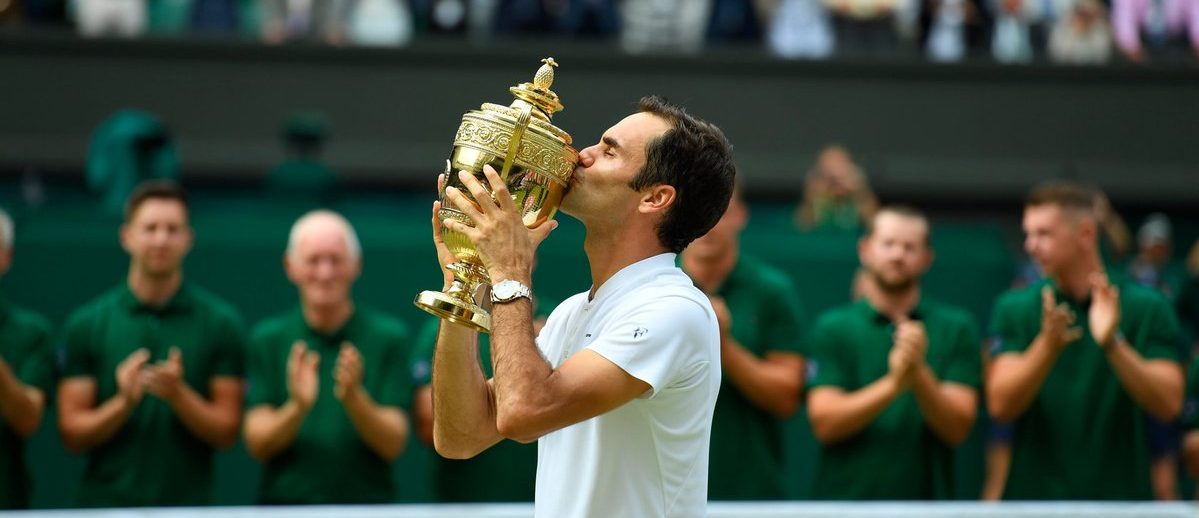
Photo credit: Wimbledon
By Stefan Ortega, Academy Director, and Pep Plasin, Head of Gilrs Area, at Sánchez-Casal Academy, Barcelona.
Roger Federer, at 36 years of age, has come to the end of a new season of success and is, along with Rafa Nadal, the tennis player with the highest number of Grand Slams in history. However, Roger began the season after a 2016 full of injuries, troubles and disappointments. What happened to him in 2017? What put him back up to No. 2 after finishing last year in 16th place on the ATP ranking?
If we review the 4 core pillars of tennis (technical, tactical, physical and mental), we can see changes and progress in all of them.
Firstly, Federer has made one change that is visible to everyone: he got a new racket. Now he is playing with a racket with a wider frame and bigger head, which provides him with greater comfort in all of his shots. He has gained in ball speed while using less effort, something which is very noticeable, especially in his serves.
Secondly, Federer, as ever, is in exceptional physical condition. Although in 2016 he suffered a series of injuries, he has a privileged physique that, together with his exceptional technique, means that he can achieve more with less effort than most. These are qualities that have always characterized Roger’s game but throughout this past season we have seen him reach an even higher physical level than in previous years. After 17 years together, Pierre Paganini, Roger’s physical trainer, knows Roger’s mental and physical abilities inside and out. Pierre has been a key factor in Roger’s recovery, having worked with him throughout his entire career, which started at 14 years of age.

Photo credit: Imago
From a technical point of view, Federer is still travelling with and influenced by Severin Luthi, a close confidant of the Swiss player, but he is also being advised by former world-class player Ivan Ljubicic. This is a relationship that has worked out well for Federer in the past. Ljubicic’s influence is definitely noticeable in Federer’s way of playing. With Edberg, Roger stepped inside the court more to shorten the points by approaching the net, using the serve-volley strategy and more aggression. An example of this in the past year is when Roger famously returned a serve standing half a meter from the service line. In contrast, with Ivan, he is playing inside the court, with a very dominant forehand and highly varied directions on his serves. The work of his topspin backhand, which more than a topspin is “half flat”, allows him a great final wrist gesture that gives the ball impressive speed. This allows him to stay up front and dominate the game in an area of the court where perhaps he used to play with excessive slice.
Finally, another one of Roger’s weapons is his ability to rapidly change speed and his capacity to surprise his rival on court. This season, we have seen Roger hit the ball very low and just short inside the court, forcing his rival to run into the court where he can only return the ball weakly as it reaches him at a very low height. Roger then surprises his rival again with a quick stroke, forcing his opponent to quickly move backwards.

Photo credit: Getty Image
Only a “wise” player has this ability to listen and learn, to improve in technique every day.
In addition, Roger has been able to take advantage of the specific regulations of the ATP for players over 31 years of age. According to these rules the mandatory number of ATP Tour Masters 1000 tournaments can be reduced by 1 when one of the following requirements is fulfilled:
– 600 games played (as of January 1st of the current year).
– 12 years active in the ATP Tour.
– 31 years old (as of January 1st of the current year).
Federer has not hesitated to take advantage of this reduced number of matches. He has chosen to have a more relaxed schedule and by doing so, has had more time to devote to physical recovery throughout the season. This shortening of his tournament calendar is probably another secret to the success of Roger’s 2017 season.
Finally, his mental game also deserves to be highlighted. Mentally, Federer now plays much more serenely. His control during matches gives his rivals the impression that Roger is playing without any stress. Roger carefully chooses his shots, plays safely and smartly, and rarely “gives away” any points. This control has flamed his status as a legend in tennis. Rival players have begun to see him “as if he was from another galaxy” and it is evident that this has affected his rivals’ performance, particularly at critical moments. Roger is a living legend, perhaps even the best tennis player in history.

Photo credit: Cameron Spencer, Getty Image
There is, however, one constant factor that has been present throughout Roger Federer’s career, and it is, without a doubt, the key to his almost 20 years of success: his desire to constantly improve, progress and excel. His constant aim to “be better” makes him the perfect inspiration for all those players who aspire to compete among the best in the future. Thank you, Roger, for being an example to follow.
Stefan Ortega, Academy Director
Pep Plasin, Head of Gilrs Area
Sánchez-Casal Academy, Barcelona
















